The Role of Automobile Industry in Today's Era
VerifiedAdded on 2021/04/16
|11
|2541
|47
AI Summary
The given assignment is a detailed analysis of the automobile industry's role in today's era. It discusses the various changes that have occurred in recent years, including the introduction of hybrid and electric cars, as well as the increasing collaboration among partners. The assignment also delves into the patterns involved in global value chains and their relevance to the industry.
Contribute Materials
Your contribution can guide someone’s learning journey. Share your
documents today.
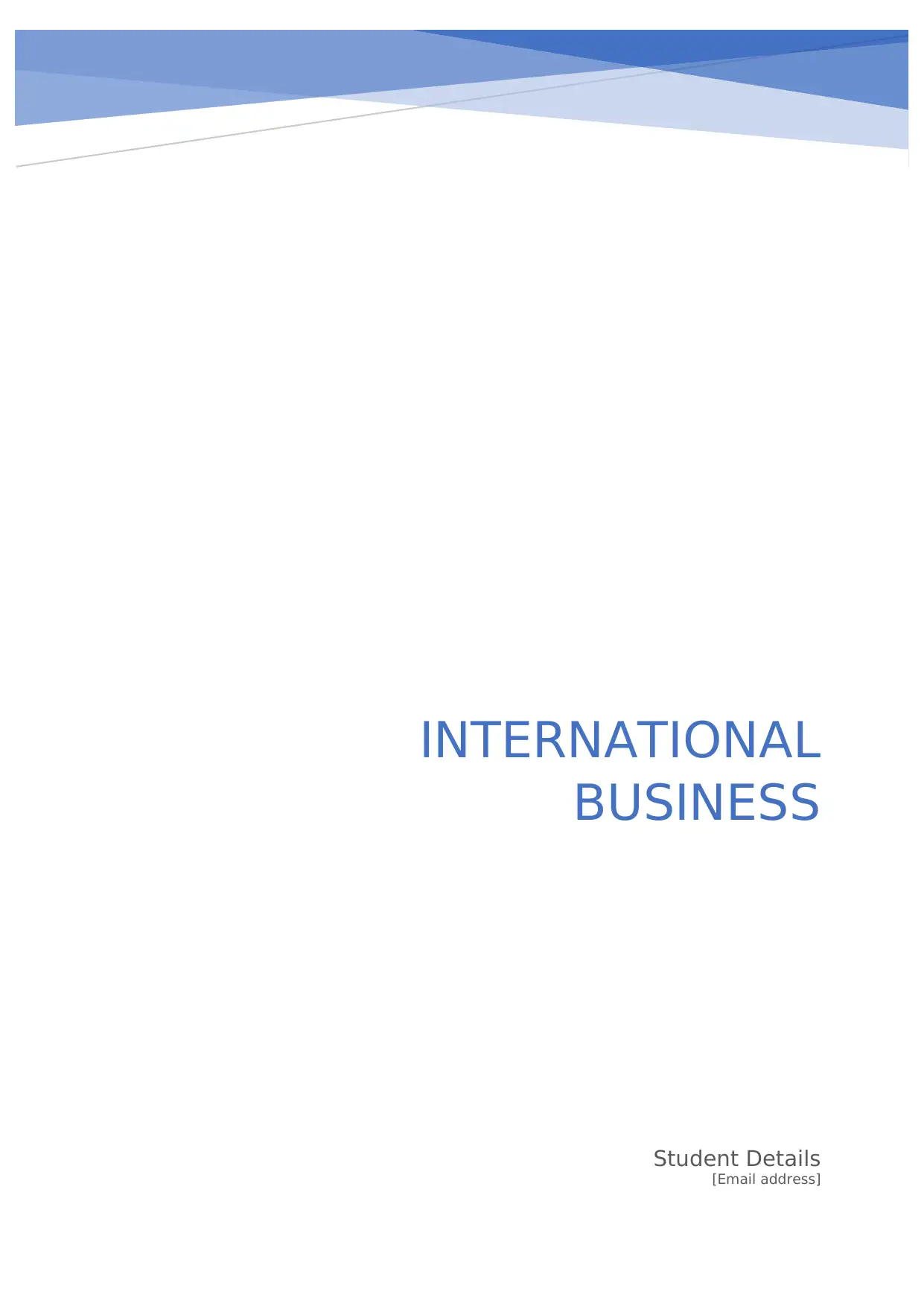
RUNNING
Student Details
[Email address]
INTERNATIONAL
BUSINESS
Student Details
[Email address]
INTERNATIONAL
BUSINESS
Secure Best Marks with AI Grader
Need help grading? Try our AI Grader for instant feedback on your assignments.

International Business 1
Introduction
An automobile industry is a wide platform where huge number of companies and
organizations get involved in designing, developing, manufacturing, marketing and selling
vehicles which also aims at contributing the world in terms of revenue.
Major trends in Automobile Industry
There have been drastic changes in the automobile industry in last few years. The major two
changes seen are mentioned below.
Increasing number of hybrid and electric cars
Hybrid cars and electric cars are in trend in recent years. According to the research conducted
in United States, it has been found that the sale for these cars has raised 45% in 2017 as
compared to the demand in 2016. The trend of these cars will be followed because they aim
at manufacturing cheaper batteries and more robust charging infrastructure which helps to cut
the cost of electric cars. They basically aim at focusing on the power and drive train systems
which include clutch, rear axle, propeller shaft yoke and propeller shaft. The taxes charged by
government on these cars are comparable lower than those involved in diesel cars (Youngs,
2012).
For example, Volvo is expected to emit 30% less CO2 and save the fuel of 5-10% by
adopting a hybrid long haul truck. The company has also planned to update its drive train
which will decide the best time to use diesel cars and electric cars.
Likewise, Tesla has built its image by selling 28000 of S model and Chevy has sold 25800 of
its hybrid volts. However, Toyota’s Prius Prime is known as the third highest selling electric
hybrid company in 2017.
Collaboration
Today, many companies are highly involved in building partnership with IT companies such
as Toyota and Microsoft, Google and Honda and Volvo and NVidia and many more.
Similarly, many automobile companies are also getting more involved with each other which
was not in trend few years back. The main reason behind the interconnection is the strategic
alliances.
For an instance, Mahindra and Mahindra entered into a strategic alliance with US Company
named Ford Motor in order to create cooperation in terms of products, technology,
Introduction
An automobile industry is a wide platform where huge number of companies and
organizations get involved in designing, developing, manufacturing, marketing and selling
vehicles which also aims at contributing the world in terms of revenue.
Major trends in Automobile Industry
There have been drastic changes in the automobile industry in last few years. The major two
changes seen are mentioned below.
Increasing number of hybrid and electric cars
Hybrid cars and electric cars are in trend in recent years. According to the research conducted
in United States, it has been found that the sale for these cars has raised 45% in 2017 as
compared to the demand in 2016. The trend of these cars will be followed because they aim
at manufacturing cheaper batteries and more robust charging infrastructure which helps to cut
the cost of electric cars. They basically aim at focusing on the power and drive train systems
which include clutch, rear axle, propeller shaft yoke and propeller shaft. The taxes charged by
government on these cars are comparable lower than those involved in diesel cars (Youngs,
2012).
For example, Volvo is expected to emit 30% less CO2 and save the fuel of 5-10% by
adopting a hybrid long haul truck. The company has also planned to update its drive train
which will decide the best time to use diesel cars and electric cars.
Likewise, Tesla has built its image by selling 28000 of S model and Chevy has sold 25800 of
its hybrid volts. However, Toyota’s Prius Prime is known as the third highest selling electric
hybrid company in 2017.
Collaboration
Today, many companies are highly involved in building partnership with IT companies such
as Toyota and Microsoft, Google and Honda and Volvo and NVidia and many more.
Similarly, many automobile companies are also getting more involved with each other which
was not in trend few years back. The main reason behind the interconnection is the strategic
alliances.
For an instance, Mahindra and Mahindra entered into a strategic alliance with US Company
named Ford Motor in order to create cooperation in terms of products, technology,
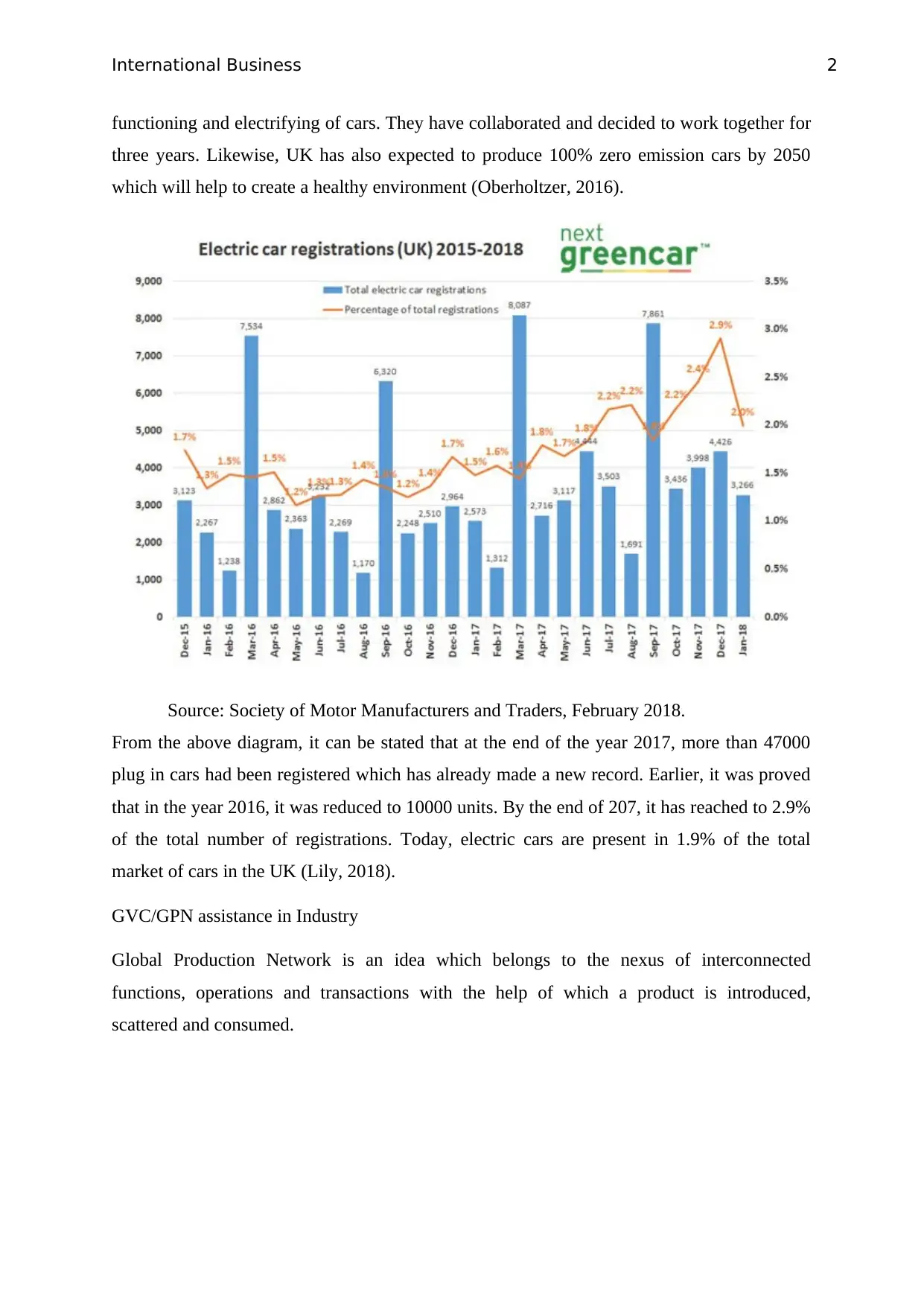
International Business 2
functioning and electrifying of cars. They have collaborated and decided to work together for
three years. Likewise, UK has also expected to produce 100% zero emission cars by 2050
which will help to create a healthy environment (Oberholtzer, 2016).
Source: Society of Motor Manufacturers and Traders, February 2018.
From the above diagram, it can be stated that at the end of the year 2017, more than 47000
plug in cars had been registered which has already made a new record. Earlier, it was proved
that in the year 2016, it was reduced to 10000 units. By the end of 207, it has reached to 2.9%
of the total number of registrations. Today, electric cars are present in 1.9% of the total
market of cars in the UK (Lily, 2018).
GVC/GPN assistance in Industry
Global Production Network is an idea which belongs to the nexus of interconnected
functions, operations and transactions with the help of which a product is introduced,
scattered and consumed.
functioning and electrifying of cars. They have collaborated and decided to work together for
three years. Likewise, UK has also expected to produce 100% zero emission cars by 2050
which will help to create a healthy environment (Oberholtzer, 2016).
Source: Society of Motor Manufacturers and Traders, February 2018.
From the above diagram, it can be stated that at the end of the year 2017, more than 47000
plug in cars had been registered which has already made a new record. Earlier, it was proved
that in the year 2016, it was reduced to 10000 units. By the end of 207, it has reached to 2.9%
of the total number of registrations. Today, electric cars are present in 1.9% of the total
market of cars in the UK (Lily, 2018).
GVC/GPN assistance in Industry
Global Production Network is an idea which belongs to the nexus of interconnected
functions, operations and transactions with the help of which a product is introduced,
scattered and consumed.
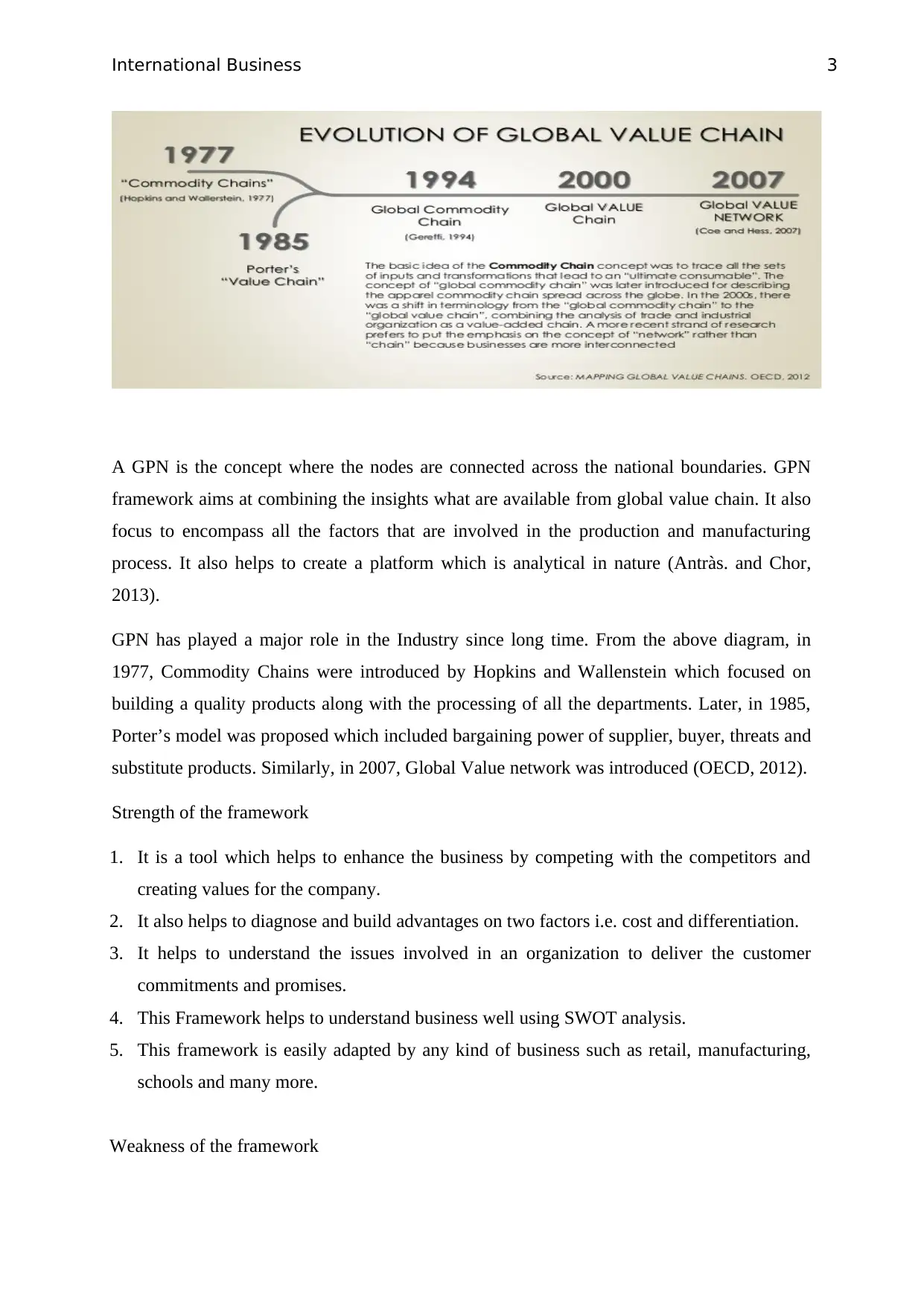
International Business 3
A GPN is the concept where the nodes are connected across the national boundaries. GPN
framework aims at combining the insights what are available from global value chain. It also
focus to encompass all the factors that are involved in the production and manufacturing
process. It also helps to create a platform which is analytical in nature (Antràs. and Chor,
2013).
GPN has played a major role in the Industry since long time. From the above diagram, in
1977, Commodity Chains were introduced by Hopkins and Wallenstein which focused on
building a quality products along with the processing of all the departments. Later, in 1985,
Porter’s model was proposed which included bargaining power of supplier, buyer, threats and
substitute products. Similarly, in 2007, Global Value network was introduced (OECD, 2012).
Strength of the framework
1. It is a tool which helps to enhance the business by competing with the competitors and
creating values for the company.
2. It also helps to diagnose and build advantages on two factors i.e. cost and differentiation.
3. It helps to understand the issues involved in an organization to deliver the customer
commitments and promises.
4. This Framework helps to understand business well using SWOT analysis.
5. This framework is easily adapted by any kind of business such as retail, manufacturing,
schools and many more.
Weakness of the framework
A GPN is the concept where the nodes are connected across the national boundaries. GPN
framework aims at combining the insights what are available from global value chain. It also
focus to encompass all the factors that are involved in the production and manufacturing
process. It also helps to create a platform which is analytical in nature (Antràs. and Chor,
2013).
GPN has played a major role in the Industry since long time. From the above diagram, in
1977, Commodity Chains were introduced by Hopkins and Wallenstein which focused on
building a quality products along with the processing of all the departments. Later, in 1985,
Porter’s model was proposed which included bargaining power of supplier, buyer, threats and
substitute products. Similarly, in 2007, Global Value network was introduced (OECD, 2012).
Strength of the framework
1. It is a tool which helps to enhance the business by competing with the competitors and
creating values for the company.
2. It also helps to diagnose and build advantages on two factors i.e. cost and differentiation.
3. It helps to understand the issues involved in an organization to deliver the customer
commitments and promises.
4. This Framework helps to understand business well using SWOT analysis.
5. This framework is easily adapted by any kind of business such as retail, manufacturing,
schools and many more.
Weakness of the framework
Secure Best Marks with AI Grader
Need help grading? Try our AI Grader for instant feedback on your assignments.
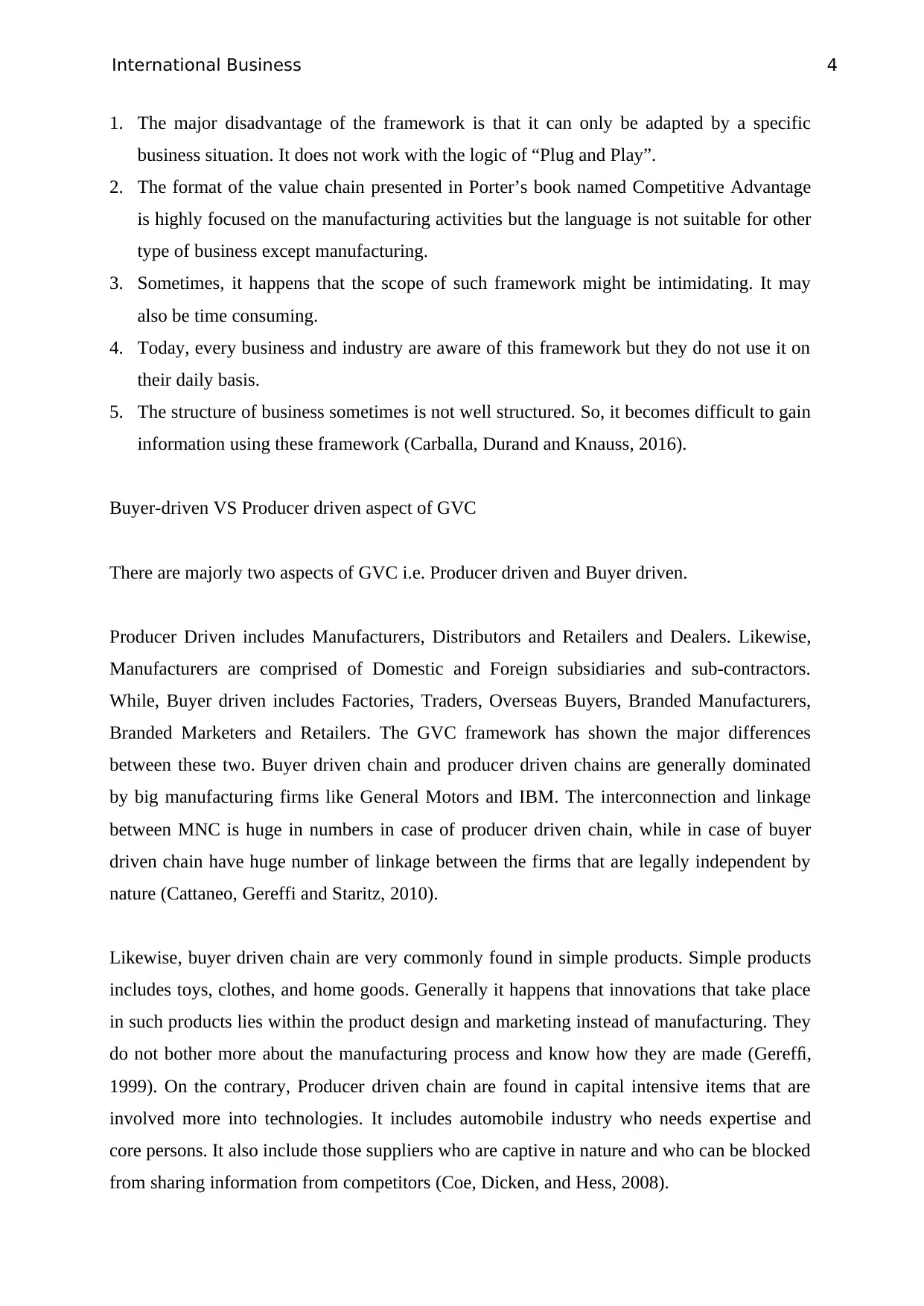
International Business 4
1. The major disadvantage of the framework is that it can only be adapted by a specific
business situation. It does not work with the logic of “Plug and Play”.
2. The format of the value chain presented in Porter’s book named Competitive Advantage
is highly focused on the manufacturing activities but the language is not suitable for other
type of business except manufacturing.
3. Sometimes, it happens that the scope of such framework might be intimidating. It may
also be time consuming.
4. Today, every business and industry are aware of this framework but they do not use it on
their daily basis.
5. The structure of business sometimes is not well structured. So, it becomes difficult to gain
information using these framework (Carballa, Durand and Knauss, 2016).
Buyer-driven VS Producer driven aspect of GVC
There are majorly two aspects of GVC i.e. Producer driven and Buyer driven.
Producer Driven includes Manufacturers, Distributors and Retailers and Dealers. Likewise,
Manufacturers are comprised of Domestic and Foreign subsidiaries and sub-contractors.
While, Buyer driven includes Factories, Traders, Overseas Buyers, Branded Manufacturers,
Branded Marketers and Retailers. The GVC framework has shown the major differences
between these two. Buyer driven chain and producer driven chains are generally dominated
by big manufacturing firms like General Motors and IBM. The interconnection and linkage
between MNC is huge in numbers in case of producer driven chain, while in case of buyer
driven chain have huge number of linkage between the firms that are legally independent by
nature (Cattaneo, Gereffi and Staritz, 2010).
Likewise, buyer driven chain are very commonly found in simple products. Simple products
includes toys, clothes, and home goods. Generally it happens that innovations that take place
in such products lies within the product design and marketing instead of manufacturing. They
do not bother more about the manufacturing process and know how they are made (Gereffi,
1999). On the contrary, Producer driven chain are found in capital intensive items that are
involved more into technologies. It includes automobile industry who needs expertise and
core persons. It also include those suppliers who are captive in nature and who can be blocked
from sharing information from competitors (Coe, Dicken, and Hess, 2008).
1. The major disadvantage of the framework is that it can only be adapted by a specific
business situation. It does not work with the logic of “Plug and Play”.
2. The format of the value chain presented in Porter’s book named Competitive Advantage
is highly focused on the manufacturing activities but the language is not suitable for other
type of business except manufacturing.
3. Sometimes, it happens that the scope of such framework might be intimidating. It may
also be time consuming.
4. Today, every business and industry are aware of this framework but they do not use it on
their daily basis.
5. The structure of business sometimes is not well structured. So, it becomes difficult to gain
information using these framework (Carballa, Durand and Knauss, 2016).
Buyer-driven VS Producer driven aspect of GVC
There are majorly two aspects of GVC i.e. Producer driven and Buyer driven.
Producer Driven includes Manufacturers, Distributors and Retailers and Dealers. Likewise,
Manufacturers are comprised of Domestic and Foreign subsidiaries and sub-contractors.
While, Buyer driven includes Factories, Traders, Overseas Buyers, Branded Manufacturers,
Branded Marketers and Retailers. The GVC framework has shown the major differences
between these two. Buyer driven chain and producer driven chains are generally dominated
by big manufacturing firms like General Motors and IBM. The interconnection and linkage
between MNC is huge in numbers in case of producer driven chain, while in case of buyer
driven chain have huge number of linkage between the firms that are legally independent by
nature (Cattaneo, Gereffi and Staritz, 2010).
Likewise, buyer driven chain are very commonly found in simple products. Simple products
includes toys, clothes, and home goods. Generally it happens that innovations that take place
in such products lies within the product design and marketing instead of manufacturing. They
do not bother more about the manufacturing process and know how they are made (Gereffi,
1999). On the contrary, Producer driven chain are found in capital intensive items that are
involved more into technologies. It includes automobile industry who needs expertise and
core persons. It also include those suppliers who are captive in nature and who can be blocked
from sharing information from competitors (Coe, Dicken, and Hess, 2008).
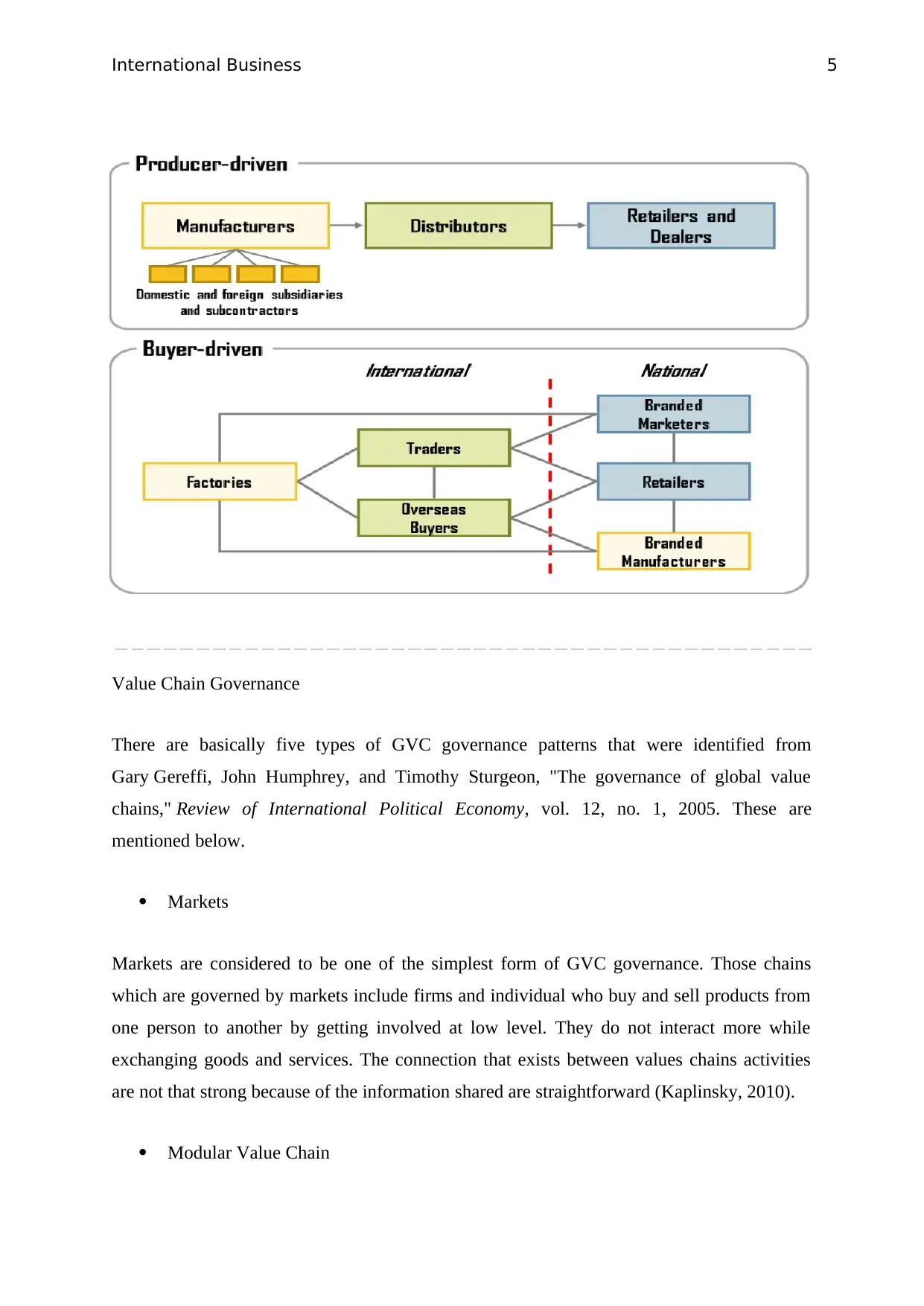
International Business 5
Value Chain Governance
There are basically five types of GVC governance patterns that were identified from
Gary Gereffi, John Humphrey, and Timothy Sturgeon, "The governance of global value
chains," Review of International Political Economy, vol. 12, no. 1, 2005. These are
mentioned below.
Markets
Markets are considered to be one of the simplest form of GVC governance. Those chains
which are governed by markets include firms and individual who buy and sell products from
one person to another by getting involved at low level. They do not interact more while
exchanging goods and services. The connection that exists between values chains activities
are not that strong because of the information shared are straightforward (Kaplinsky, 2010).
Modular Value Chain
Value Chain Governance
There are basically five types of GVC governance patterns that were identified from
Gary Gereffi, John Humphrey, and Timothy Sturgeon, "The governance of global value
chains," Review of International Political Economy, vol. 12, no. 1, 2005. These are
mentioned below.
Markets
Markets are considered to be one of the simplest form of GVC governance. Those chains
which are governed by markets include firms and individual who buy and sell products from
one person to another by getting involved at low level. They do not interact more while
exchanging goods and services. The connection that exists between values chains activities
are not that strong because of the information shared are straightforward (Kaplinsky, 2010).
Modular Value Chain
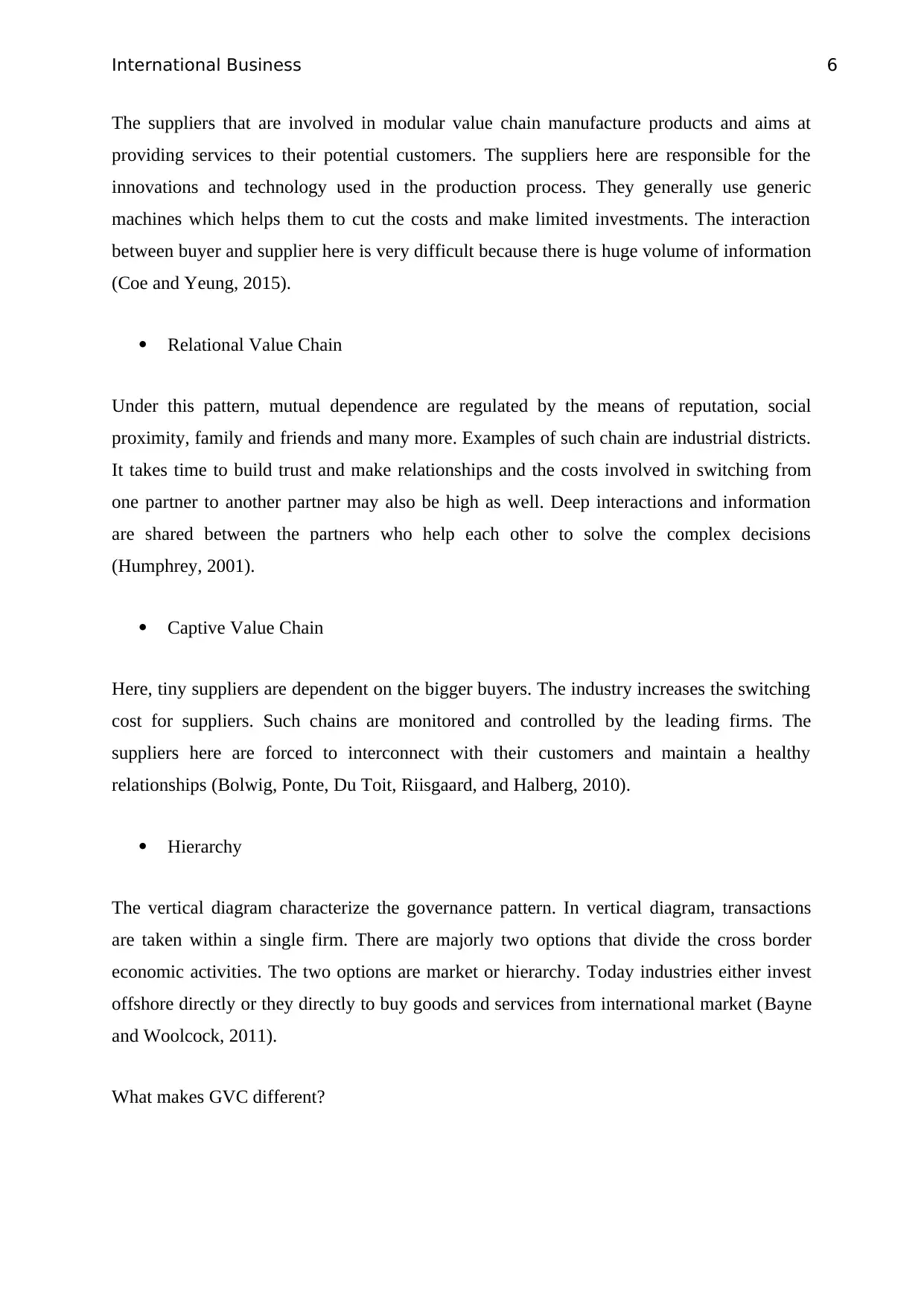
International Business 6
The suppliers that are involved in modular value chain manufacture products and aims at
providing services to their potential customers. The suppliers here are responsible for the
innovations and technology used in the production process. They generally use generic
machines which helps them to cut the costs and make limited investments. The interaction
between buyer and supplier here is very difficult because there is huge volume of information
(Coe and Yeung, 2015).
Relational Value Chain
Under this pattern, mutual dependence are regulated by the means of reputation, social
proximity, family and friends and many more. Examples of such chain are industrial districts.
It takes time to build trust and make relationships and the costs involved in switching from
one partner to another partner may also be high as well. Deep interactions and information
are shared between the partners who help each other to solve the complex decisions
(Humphrey, 2001).
Captive Value Chain
Here, tiny suppliers are dependent on the bigger buyers. The industry increases the switching
cost for suppliers. Such chains are monitored and controlled by the leading firms. The
suppliers here are forced to interconnect with their customers and maintain a healthy
relationships (Bolwig, Ponte, Du Toit, Riisgaard, and Halberg, 2010).
Hierarchy
The vertical diagram characterize the governance pattern. In vertical diagram, transactions
are taken within a single firm. There are majorly two options that divide the cross border
economic activities. The two options are market or hierarchy. Today industries either invest
offshore directly or they directly to buy goods and services from international market (Bayne
and Woolcock, 2011).
What makes GVC different?
The suppliers that are involved in modular value chain manufacture products and aims at
providing services to their potential customers. The suppliers here are responsible for the
innovations and technology used in the production process. They generally use generic
machines which helps them to cut the costs and make limited investments. The interaction
between buyer and supplier here is very difficult because there is huge volume of information
(Coe and Yeung, 2015).
Relational Value Chain
Under this pattern, mutual dependence are regulated by the means of reputation, social
proximity, family and friends and many more. Examples of such chain are industrial districts.
It takes time to build trust and make relationships and the costs involved in switching from
one partner to another partner may also be high as well. Deep interactions and information
are shared between the partners who help each other to solve the complex decisions
(Humphrey, 2001).
Captive Value Chain
Here, tiny suppliers are dependent on the bigger buyers. The industry increases the switching
cost for suppliers. Such chains are monitored and controlled by the leading firms. The
suppliers here are forced to interconnect with their customers and maintain a healthy
relationships (Bolwig, Ponte, Du Toit, Riisgaard, and Halberg, 2010).
Hierarchy
The vertical diagram characterize the governance pattern. In vertical diagram, transactions
are taken within a single firm. There are majorly two options that divide the cross border
economic activities. The two options are market or hierarchy. Today industries either invest
offshore directly or they directly to buy goods and services from international market (Bayne
and Woolcock, 2011).
What makes GVC different?
Paraphrase This Document
Need a fresh take? Get an instant paraphrase of this document with our AI Paraphraser
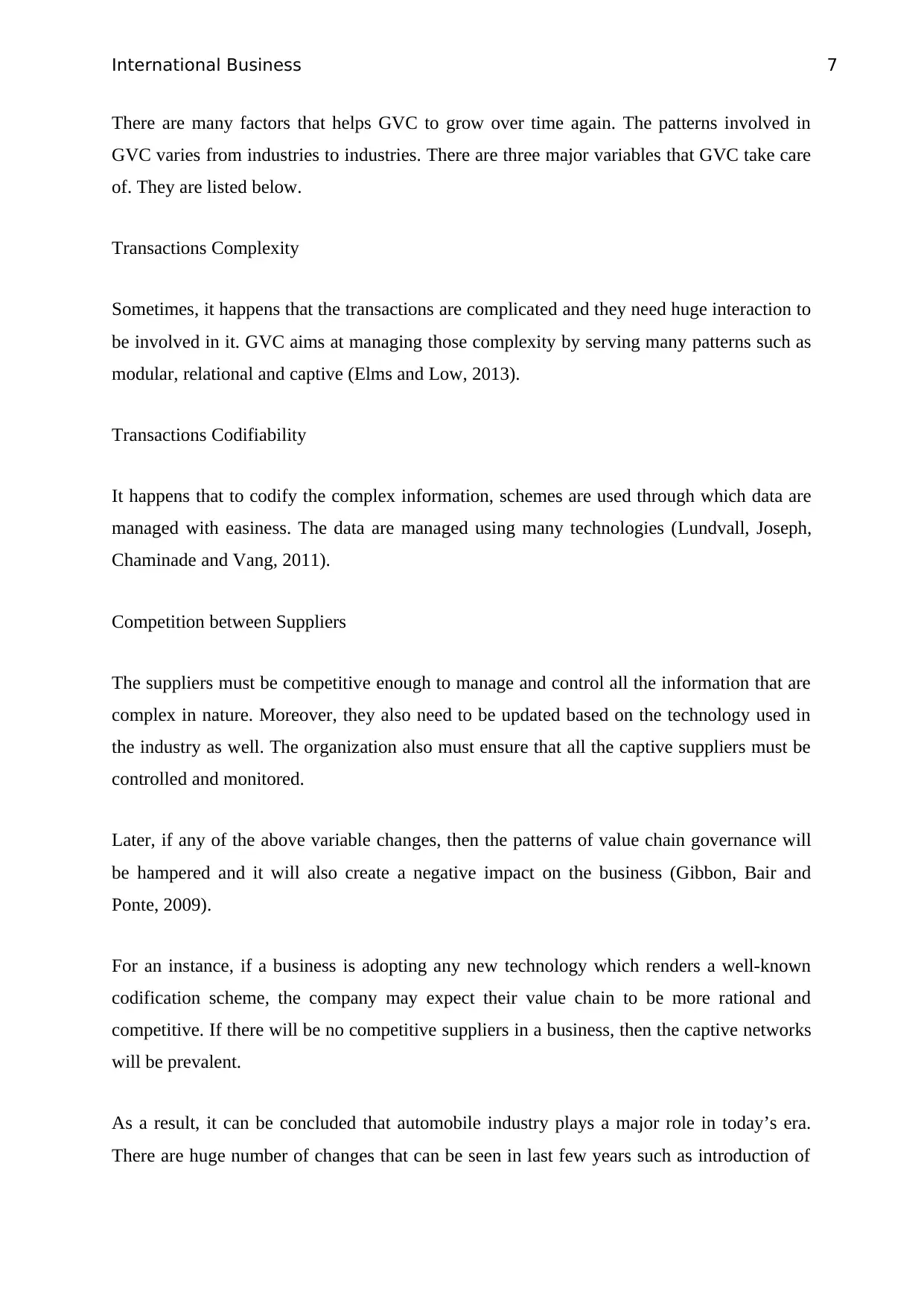
International Business 7
There are many factors that helps GVC to grow over time again. The patterns involved in
GVC varies from industries to industries. There are three major variables that GVC take care
of. They are listed below.
Transactions Complexity
Sometimes, it happens that the transactions are complicated and they need huge interaction to
be involved in it. GVC aims at managing those complexity by serving many patterns such as
modular, relational and captive (Elms and Low, 2013).
Transactions Codifiability
It happens that to codify the complex information, schemes are used through which data are
managed with easiness. The data are managed using many technologies (Lundvall, Joseph,
Chaminade and Vang, 2011).
Competition between Suppliers
The suppliers must be competitive enough to manage and control all the information that are
complex in nature. Moreover, they also need to be updated based on the technology used in
the industry as well. The organization also must ensure that all the captive suppliers must be
controlled and monitored.
Later, if any of the above variable changes, then the patterns of value chain governance will
be hampered and it will also create a negative impact on the business (Gibbon, Bair and
Ponte, 2009).
For an instance, if a business is adopting any new technology which renders a well-known
codification scheme, the company may expect their value chain to be more rational and
competitive. If there will be no competitive suppliers in a business, then the captive networks
will be prevalent.
As a result, it can be concluded that automobile industry plays a major role in today’s era.
There are huge number of changes that can be seen in last few years such as introduction of
There are many factors that helps GVC to grow over time again. The patterns involved in
GVC varies from industries to industries. There are three major variables that GVC take care
of. They are listed below.
Transactions Complexity
Sometimes, it happens that the transactions are complicated and they need huge interaction to
be involved in it. GVC aims at managing those complexity by serving many patterns such as
modular, relational and captive (Elms and Low, 2013).
Transactions Codifiability
It happens that to codify the complex information, schemes are used through which data are
managed with easiness. The data are managed using many technologies (Lundvall, Joseph,
Chaminade and Vang, 2011).
Competition between Suppliers
The suppliers must be competitive enough to manage and control all the information that are
complex in nature. Moreover, they also need to be updated based on the technology used in
the industry as well. The organization also must ensure that all the captive suppliers must be
controlled and monitored.
Later, if any of the above variable changes, then the patterns of value chain governance will
be hampered and it will also create a negative impact on the business (Gibbon, Bair and
Ponte, 2009).
For an instance, if a business is adopting any new technology which renders a well-known
codification scheme, the company may expect their value chain to be more rational and
competitive. If there will be no competitive suppliers in a business, then the captive networks
will be prevalent.
As a result, it can be concluded that automobile industry plays a major role in today’s era.
There are huge number of changes that can be seen in last few years such as introduction of

International Business 8
hybrid and electric cars and the collaboration of many partners. Moreover, there are many
patterns that are involved in GVC and those patterns are generally followed by many
industries.
hybrid and electric cars and the collaboration of many partners. Moreover, there are many
patterns that are involved in GVC and those patterns are generally followed by many
industries.

International Business 9
References
Antràs, P. and Chor, D., 2013. Organizing the global value chain. Econometrica, 81(6),
pp.2127-2204.
Bayne, N. and Woolcock, S. eds., 2011. The new economic diplomacy: decision-making and
negotiation in international economic relations. Ashgate Publishing, Ltd.
Bolwig, S., Ponte, S., Du Toit, A., Riisgaard, L. and Halberg, N., 2010. Integrating poverty
and environmental concerns into value‐chain analysis: a conceptual framework. Development
Policy Review, 28(2), pp.173-194.
Carballa Smichowski, B., Durand, C. and Knauss, S., 2016. Uneven development patterns in
global value chains. HAL.
Cattaneo, O., Gereffi, G. and Staritz, C. eds., 2010. Global value chains in a postcrisis world:
a development perspective. World Bank Publications.
Coe, M. N., Peter Dicken, P. and Martin Hess, M. 2008. Global production networks:
realizing the potential. Journal of Economic Geography. Volume 8.
Coe, N.M. and Yeung, H.W.C., 2015. Global production networks: Theorizing economic
development in an interconnected world. Oxford University Press.
Elms, D.K. and Low, P. eds., 2013. Global value chains in a changing world. Geneva: World
Trade Organization.
Gereffi, G., 1999. International trade and industrial upgrading in the apparel commodity
chain. Journal of International Economics. Volume 48.
Gibbon, P., Bair, J. and Ponte, S., 2009. Governing global value chains: an introduction.
Economy and Society. Volume 37 (3).
Humphrey, J., 2001. Governance in global value chains. IDS bulletin, 32(3), pp.19-29.
Kaplinsky, R., 2010. The role of standards in global value chains.
Lilly, C., 2018, Electric car market statistics, viewed on 3rd March, 2018. Available at:
http://www.nextgreencar.com/electric-cars/statistics/
Lundvall, B.Å., Joseph, K.J., Chaminade, C. and Vang, J. eds., 2011. Handbook of innovation
systems and developing countries: building domestic capabilities in a global setting. Edward
Elgar Publishing.
Oberholtzer, S., 2016, why the new era of auto industry collaboration creates risks, viewed
on 3rd March, 2018. Available at:
References
Antràs, P. and Chor, D., 2013. Organizing the global value chain. Econometrica, 81(6),
pp.2127-2204.
Bayne, N. and Woolcock, S. eds., 2011. The new economic diplomacy: decision-making and
negotiation in international economic relations. Ashgate Publishing, Ltd.
Bolwig, S., Ponte, S., Du Toit, A., Riisgaard, L. and Halberg, N., 2010. Integrating poverty
and environmental concerns into value‐chain analysis: a conceptual framework. Development
Policy Review, 28(2), pp.173-194.
Carballa Smichowski, B., Durand, C. and Knauss, S., 2016. Uneven development patterns in
global value chains. HAL.
Cattaneo, O., Gereffi, G. and Staritz, C. eds., 2010. Global value chains in a postcrisis world:
a development perspective. World Bank Publications.
Coe, M. N., Peter Dicken, P. and Martin Hess, M. 2008. Global production networks:
realizing the potential. Journal of Economic Geography. Volume 8.
Coe, N.M. and Yeung, H.W.C., 2015. Global production networks: Theorizing economic
development in an interconnected world. Oxford University Press.
Elms, D.K. and Low, P. eds., 2013. Global value chains in a changing world. Geneva: World
Trade Organization.
Gereffi, G., 1999. International trade and industrial upgrading in the apparel commodity
chain. Journal of International Economics. Volume 48.
Gibbon, P., Bair, J. and Ponte, S., 2009. Governing global value chains: an introduction.
Economy and Society. Volume 37 (3).
Humphrey, J., 2001. Governance in global value chains. IDS bulletin, 32(3), pp.19-29.
Kaplinsky, R., 2010. The role of standards in global value chains.
Lilly, C., 2018, Electric car market statistics, viewed on 3rd March, 2018. Available at:
http://www.nextgreencar.com/electric-cars/statistics/
Lundvall, B.Å., Joseph, K.J., Chaminade, C. and Vang, J. eds., 2011. Handbook of innovation
systems and developing countries: building domestic capabilities in a global setting. Edward
Elgar Publishing.
Oberholtzer, S., 2016, why the new era of auto industry collaboration creates risks, viewed
on 3rd March, 2018. Available at:
Secure Best Marks with AI Grader
Need help grading? Try our AI Grader for instant feedback on your assignments.

International Business 10
www.autonews.com/article/20160627/BLOG06/160629883/why-the-new-era-of-auto-
industry-collaboration-creates-risks
OECD, 2012, Trade and agriculture directorate trade committee, Viewed on 27th February,
2018. Available at:
file:///C:/Users/Neha%20Kediya_JPR/AppData/Local/Packages/Microsoft.MicrosoftEdge_8
wekyb3d8bbwe/TempState/Downloads/
2015094_805602210_OECD2012MappingGlobalValueChai.pdf
Youngs, J., 2012, The Advantages of Hybrid Cars, Viewed on 3rd March, 2018. Available at:
http://www.jdpower.com/cars/articles/safety-and-mpg/advantages-hybrid-cars
.
www.autonews.com/article/20160627/BLOG06/160629883/why-the-new-era-of-auto-
industry-collaboration-creates-risks
OECD, 2012, Trade and agriculture directorate trade committee, Viewed on 27th February,
2018. Available at:
file:///C:/Users/Neha%20Kediya_JPR/AppData/Local/Packages/Microsoft.MicrosoftEdge_8
wekyb3d8bbwe/TempState/Downloads/
2015094_805602210_OECD2012MappingGlobalValueChai.pdf
Youngs, J., 2012, The Advantages of Hybrid Cars, Viewed on 3rd March, 2018. Available at:
http://www.jdpower.com/cars/articles/safety-and-mpg/advantages-hybrid-cars
.
1 out of 11
Related Documents
Your All-in-One AI-Powered Toolkit for Academic Success.
+13062052269
info@desklib.com
Available 24*7 on WhatsApp / Email
![[object Object]](/_next/static/media/star-bottom.7253800d.svg)
Unlock your academic potential
© 2024 | Zucol Services PVT LTD | All rights reserved.




